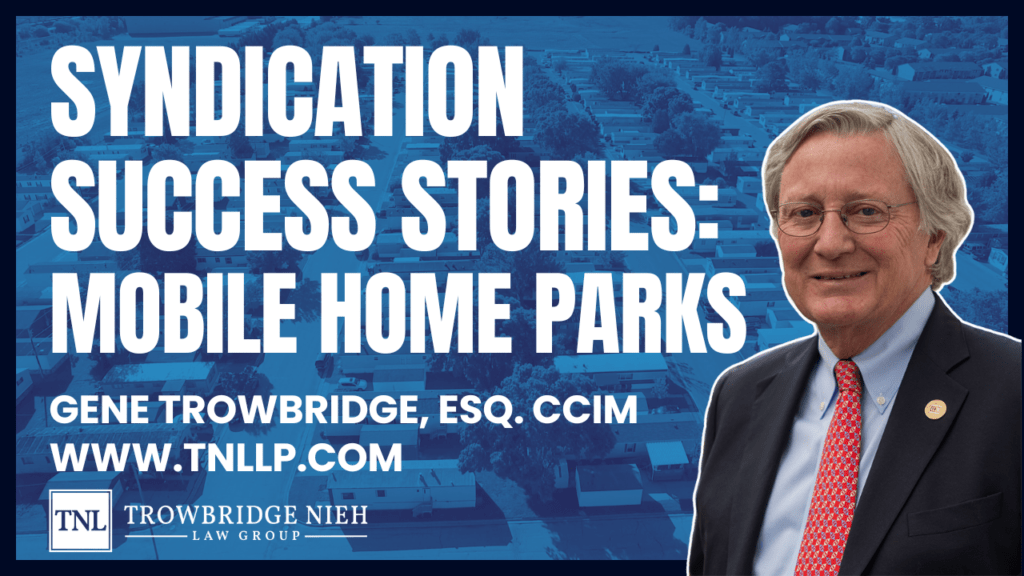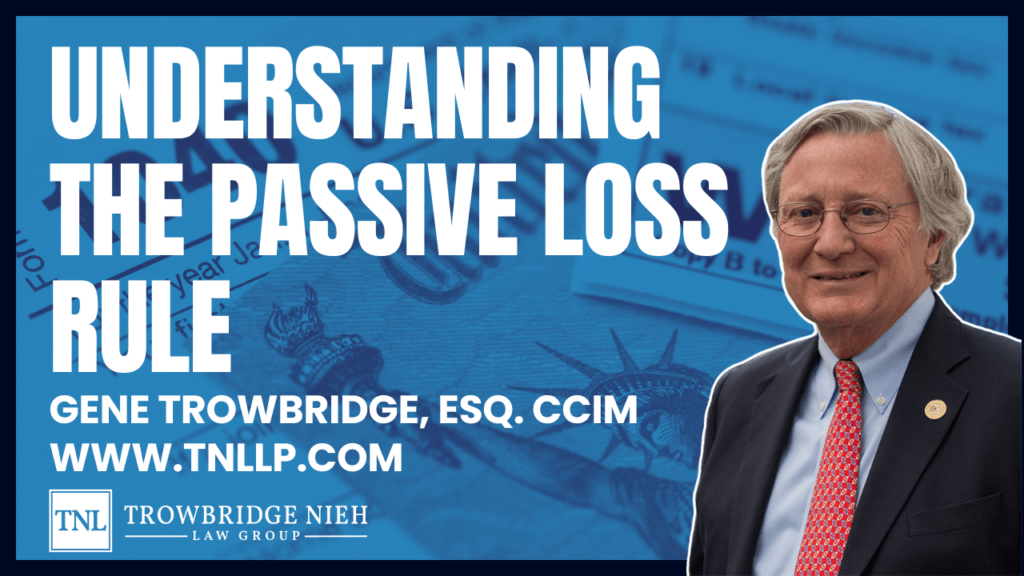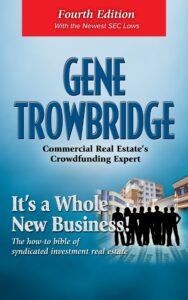In this TBD with TLG, syndication and crowdfunding attorneys Gene Trowbridge and Jon Nieh discuss three important words every syndicator, and investor, should know and understand. Those words are: sophisticated, substantive, and preexisting. Watch to get a greater understanding of their meaning and significance to syndicators.
Transcript
 | GT | - You know, Jonathan and I get a lot of calls asking us for help about the issues of doing a deal with regulation D rule 506B. And we've decided that there are three words that our clients need to know about. Hi, I'm Gene Trowbridge. And I'm here with my partner, Jonathan Neih. And Jonathan and I, and our continuing discussion of TBD, We just decided that this was going to be the TBD content about 10 minutes ago because it reflects some current calls we had yesterday and in our work, we're going to talk to you about the three words that we think are important. And in building the watch here a little bit in a 506B offering of regulation D which is where I'm sure Jonathan nine out of 10 of our clients use 506B, right? |
     | JN | - We use at least 90%, if not more. |
      | GT | - At least, at least. And in the nation, it's like 93% of all the private placements are in in 506B. There's a couple issues. Number one in 506B you can take sophisticated investors up to 35. And Jonathan, before we leave this, we haven't talked about this ahead of time because it's just, it's all TBD. Come back to me about the topic of integration which we have a call on yesterday. Okay. |
     | JN | - Okay. |
      | GT | - In 506B we can take 35 sophisticated investors because we're not advertising. So one of the questions might be what's a sophisticated investor and then the other issue is we can't advertise. So is there a defense for us against a charge of us advertising for clients? And so I'm going to talk about sophisticated. And Jonathan is going to talk about the two words that work toward our defense of being charged with advertising for an offering in 506B, which blows our exemption. And then we're in real trouble under the securities laws. So in 506B, we do get the benefits for capital formation of being able to use investors who aren't just exclusively accredited. We can use as many accredited investors as we want and we can raise as much money as we want. But in addition to that, we can open up our fundraising to 35 people who are sophisticated. Now, sophisticated has a definition, and I'm it's not very long, but I'm going to read it. And it's right out of the SEC. And then I'll talk about it a little bit. A sophisticated investor is one who alone, or with the help of a purchaser representative or by reason of their educational, business or financial experience, and here comes the important part, can reasonably be assumed to have the capacity to understand the fundamental aspects and merits of an investment in the offering. So we're looking to people that we know and because we know them, we know that their educational business or financial experience or that they use a financial advisor. What Jimmy buffet uses Warren buffet as his financial advisor. We, we can use Jimmy there, but anyhow the person we're dealing with in a 506B is someone we know and we know enough about them in their background. And Jonathan will talk about how we know that that's the case. We know enough about them and their background to know that they can actually read the private placement memorandum, the operating agreement, and the subscription agreement and can understand the deal, understand the risks and understand enough about what they don't understand to ask the sponsor questions and get all the information before they invest. Because the, the whole premise of the securities law in having to put our offerings in writing is to give the investor all the material facts ahead of time so that it can make an informed decision on whether they should invest. And so here, we're looking at in 506B making sure that people who aren't accredited because by definition accredited people are rich and smart to figure it out themselves. We don't even need to know if an accredited person is sophisticated. We really don't. We really don't care technically but people who are not rich and smart, can they understand the information? Can they determine for themselves what the material facts are ahead of time? So that they understand the risk and decide what is if it's a good investment. And just quickly before I turn it over to Jonathan, what's a material fact? Well, material fact is anything you think that the investor would think is important for them to make a decision on whether she should invest or not. You know, and there's no bright line on what material is. It's, what's just, what does the investor think? So when we can raise money from 35 sophisticated investors and Jonathan I think we have a lot of offerings where the majority of the investors are just simply sophisticated. I mean, you could, if you knew where your remaining 15 investors, you're really could just determine that all of them are sophisticated and never worry about any of them being accredited. You could really do that. That would be, that would be fine. So there's the discussion of sophisticated not a bright line, not a task, not as easy to determine as accredited, but do they through their experience, have enough background to look at the documents and make a decision for themselves that this is where they want to invest. So that's one of the words sophisticated. Jonathan, take it away. |
     | JN | - So the other two words that we're going to be talking about are pre-existing and substantive. and I guess kind of backing up the reason why these two words are so important is because under rule 506B there is a ban on general solicitation. You cannot advertise your offering to the general public. Right. And the, the defense for that, I guess it's kind of like a safe harbor, right, to make sure that you don't you aren't generally soliciting is these two words. Making sure that all of your investors you have a preexisting relationship with them and you have a substantive relationship with them. So preexisting, what does that mean? Preexisting to what? The rule is to make sure that you, you know, follow, to make sure that you are within 506B is it's preexisting to the offering and that's kind of confusing too, right? I mean, what, what is the offering? When does the offering start? There's a lot of dates that kind of get thrown around when you're doing a real estate syndication, right? So you sign an LOI, right, with, with the property when you're trying to acquire a property. Is that the date that the offering commences? Could be. You sign a contract when you, when you signed the PSA to actually, you know, enter into a contract to buy the property. Is that the date of the offering? You know, that, that could also be as well but I'm sure a lot of the people watching this and a lot of clients with know that things change with the real estate deal. Right. You know, you might, you might decide to do this yourself instead of syndicate. You might decide to wholesale it, sell it to some other party instead of syndicates. So in our practice, you know, we we kinda have a policy of, you know, as soon as you sign with our firm as soon as you signed our fee agreement that's when the offering is being contemplated. And that's for sure when you need to, you know, have that cutoff point, right? So once you sign with our firm, you, you know, you know for a fact that you're going to do a syndication because you're hiring syndication attorneys, you know. It doesn't really matter whether or not you signed the LOI or you signed the PSA at that point, you signed with us. So, you know, you you're contemplating an offering. So our policy for our clients is that's the date that you have to use. Right? But the relationship with your investors has to preexist to the date which you sign with our firm. Simple as that. I mean, it's, it's kind of like a bright line rule that we kind of impose but that's not what the SEC, you know, imposes. The SEC just as preexisting to the offering so. Anything you wanna, you want to add to that Gene? Did I miss anything? |
      | GT | - So, Jonathan. No. I think, I think the picture that I draw, I'm building my database. I'm putting people in my database. And when I put people in my database, there's always a date on the entry of a new person into my database. And this, the offering the minute I signed the fee agreement that's the date that I can go backwards and talk to people about investing but anyone who comes in after that date, just by definition, doesn't have a pre-existing relationship. And so the easiest thing to do is, is kind of kind of freeze your database. You're always building your database but kind of freeze it for this offering at the day you fill out the, the fee agreement. Okay. |
     | JN | - And then, so for people that you meet after that day I mean, you can't take them for this offering but you could definitely keep them in your database and say, "Oh, I might have a future offering later that you might be interested in." So it's not like you can't ever use that person going forward. It's just for this specific offering that you signed with our firm with, you can't take that person. You can't, you know, ask them to invest in that, that deal. So moving on, the next word is substantive. You know, in addition, the relationship being preexisting it has to be a substantive relationship. And, you know, what does, what is substance substantive first of all, what does that mean? It means, you know, if you look at the definition for substantive, it means something of substance. It has to be, you know, important. It's not just a trivial relationship, but luckily for me the SEC actually answered this question. You know, what does, what does a substantive relationship mean? And I'm just gonna read it. And then we'll talk about that a little bit. But the SEC said that a substantive relationship is one in which the issuer has sufficient information to evaluate and does in fact, evaluate prospective investors financial circumstances, and sophistication, determining his or her status as an accredited or sophisticated investor. Self-certification alone by checking a box without any other knowledge of a person's financial circumstances or sophistication is not sufficient to form a substantive relationship. So kind of distilling that. I mean, like what, you know, the reality of, of, you know the situations that we see our clients in is, you know, you don't, you obviously don't have to verify their credit status, like how you do under 506C but you have to take some steps to, to look at this investor's financial circumstances, right? To, to going back to the definition of a sophisticated investor, someone that, you know, possesses the knowledge or experience to understand all the risks and the deal. You kind of have to know this person well enough to know whether or not they're sophisticated, basically, that's, that's kind of what substantive means. Right. I know it's kind of like circular logic, right. Like you have to know this person well enough to know whether or not they're sophisticated to invest in this deal, but it's, you know, it's, it's, I think some. One thing I always tell my clients, Gene and I don't know if you you do the same thing is I just tell them to to make sure that, you know, they're they're doing more than just talk to a person one time. Right. It, it, it's, it's more than just meeting a person and, you know getting their business card and, Oh, you know you met them at events. So you just assume that they're, you know, you know, well, you meet them at like a real estate investing event. Right. So you assume that they have certain knowledge because they're there. You have to, you know you have to reach out to them several times to actually get to know them, to get to know, you know, their investing experience, whether or not they've invested in similar deals before and also kind of like their education background. Right. So where did they go to school? Have they taken real estate investing courses? Have they, you know, have they invested in other real estate deals before? You know, that's that's kind of the advice that I usually give my clients. I don't know. What do you, what do you usually tell people, Gene? |
      | GT | - Well, the first thing I, I get when I get into this discussion with the client is some resistance from the sponsor who says, "You know I'm not a certified financial planner. I'm not a CPA. How am I to figure all this stuff out?" Well, sophisticated and substantive kind of work together. If you're interviewing, talking, getting to know the person toward the definition of being sophisticated. Is this a person who has enough background, has some advisors so that if we go through this whole thing they can understand what the offering is and they know enough about us to ask us about our track record. What have we done? Will you tell me about your next offering? I think we're on the way to having a substantive relationship. I think it's a two-way street. I think you need to know enough about the investor to know, one, are they accredited? That's fine. Or they're sophisticated. And number two, do they know enough about you and have expressed some interest to have you tell them about your next, your next offering? No bright line. And that's what some people do 506C. Not very many people do 506C because they say, "I don't want to go through all that. I just only want to take accredited investors and we'll, we'll go through a third party verification to see if they're accredited and I don't have to deal with preexisting. I don't have to deal with sophisticated. I don't have to deal with substantive." Well, I don't know about that. Let's say an investor checks a box and says that they're accredited. Okay, good. And you have another question and the question in the subscription agreement says that, you know, the minimum investment here is $250,000. And after you make the minimum investment, how much money will you have left? How much cash? And they say $10,000. Well, that, that might be accredited. That might be a substantive relationship with them so that you know how much they have but they're just not suitable. So a lot of it comes down to who's suitable to invest in your investments. So, Jonathan, I think we've gone through those three words enough to the people who are listening to keep that in mind. And if you have any questions, of course you can call us. But in the few minutes we have left I want to discuss something that came up with Jonathan and I yesterday in our business. One of our clients came to us and said, "You know I did two deals last month and I'm going to do two more deals in August. And they're 506B deals. And I'm concerned about the 35 investor rule. Someone told me," I'm speaking for what the client said, "Someone told me, Gene, that I can't have more than 35 sophisticated investors in six, within a six month period of time in my deals, and if I do I blow the exemption, which is 35 investors in a deal." And that's an interesting comment. And what Jonathan and I are worried about is that comment is running through this group because in this group, there's a lot of communication back and forth, against, amongst the sponsors. And I hope that isn't really what they're thinking. And so I was able to send him something that we have that says, you know, the integration issue, there are reasons that the SEC would integrate different offerings into one. And here's an example. You go out and raise money from 35 people to buy some dirt. And then you go out and raise money from 35 other people to make the down payment on the loan to build the building on top of the dirt. Isn't that one offering? And there would be some argument that it is or could be some argument that it isn't, but I would err on the side of caution that that's one particular offering. So if in that case, you really have 70, 70 sophisticated investors and you're you're in trouble if someone comes to look at your deal. But for our client what he had is the last month, he had two separate properties with two different loans, two different PPMS, two offering agreement. Sure. There was a lot of similarity but it wasn't the same investors in every deal, totally. It wasn't the same properties. It wasn't the same loan. So there, there are five items that go into integration. And two of them we just blew away with having different properties and different financing arrangements. So that would not be integration and our client doesn't have to worry about the next two deals they're bringing out in August. And on top of it, there is a safe Harbor. And this is what he I guess, was referring to. There is a safe harbor that in a six month period of time if you don't have more than 35 sophisticated investors in all of your offerings, it's a safe Harbor. You're just fine. So no matter what, if you did, you know, a number of offerings, but collectively you didn't have more than 35. You don't have to go through the five step process. It's just safe harbor that we're not going to worry about integration, but our prolific syndicator's will do a couple deals, you know, two or three deals every six months. And so we need to know, and everyone needs to know that we don't need that integration deal. Okay. So that's, that's pretty good. Jonathan we've covered the three words sophisticated, preexisting, substantive. We talked a little bit about integration, which might've been in the weeds a little bit, but it was something that came up yesterday and that's the whole process of TBD. So Jonathan, thanks a lot for this. And I want to tell everyone who's watching to subscribe to our YouTube channel. When you do subscribe to our YouTube channel make sure you send us an email, we'll reach out to you and see how we can mail you a copy of my book, "It's a Whole New Business" and maybe even an autographed copy of my book for subscribing. So thanks very much. And we'll see you next week. Same time Same place. Thank you. |





